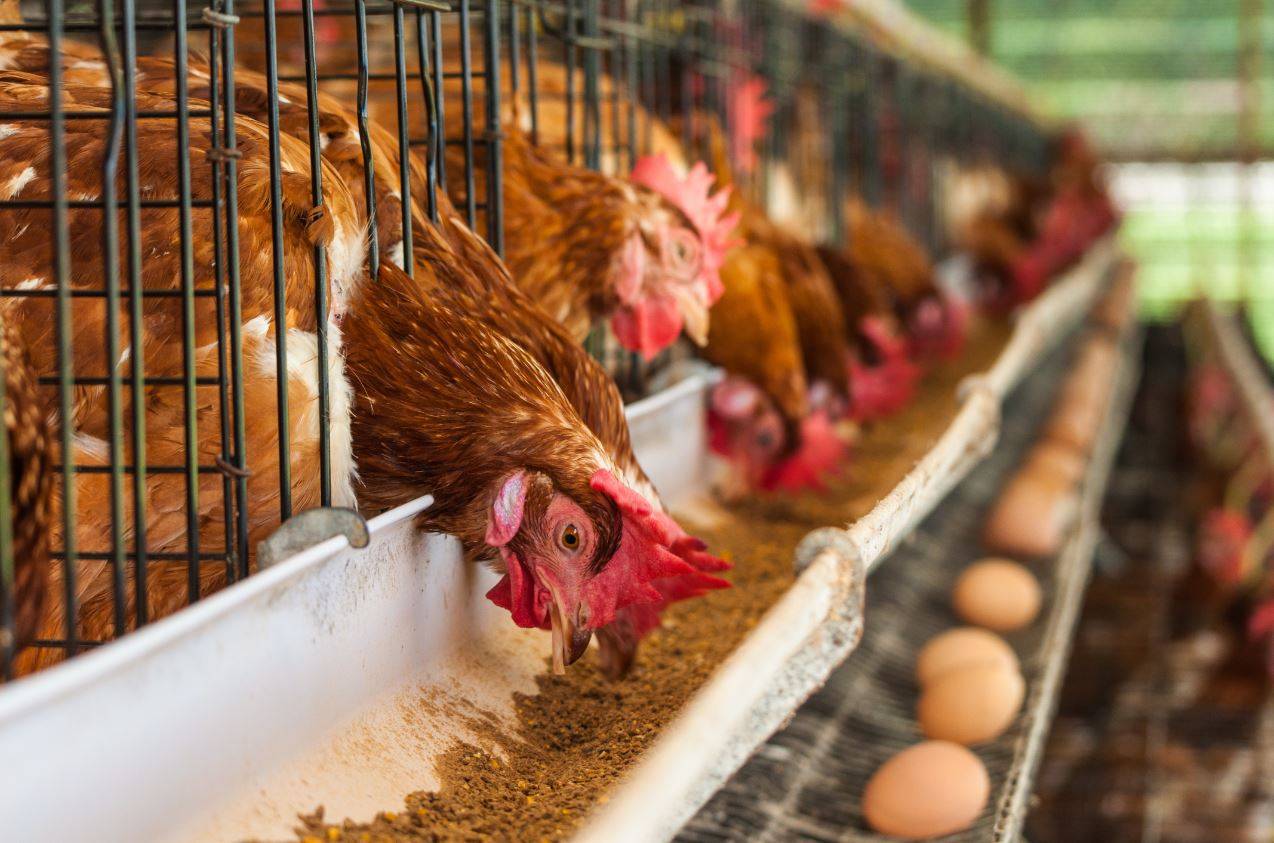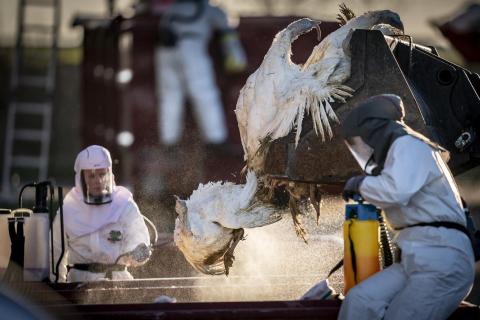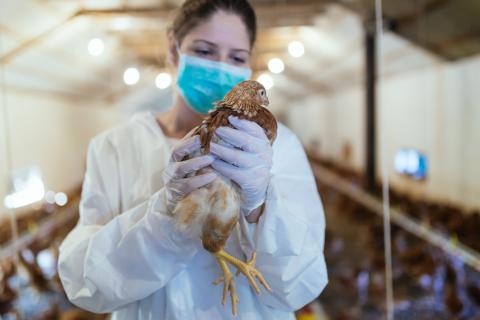Reactions: bird flu cases detected in Spain in 2022 were not real infections
Analysis of the two asymptomatic cases of H5N1 avian influenza detected in Spain in autumn 2022 in workers at a poultry farm in Guadalajara has confirmed the theory that no actual infections occurred, but that both were in contact with genetic material of the virus found in the environment. Spain has recently modified its protocols, according to the analysis published in Eurosurveillance.
The sentence "Spain will modify its protocols" has been changed to "Spain has recently modified its protocols", as they were amended in February 2023.

Elisa Pérez - casos españoles gripe aviar EN
Elisa Pérez Ramírez
Researcher in the Department of Infectious Diseases and Global Health at the Centre for Animal Health Research CISA-INIA, CSIC
I find this interesting, but not surprising. It had already been commented on many occasions that these two positive cases in the workers at the farm in Guadalajara were possibly false positives. In fact, this information appears in official documents from the Ministry of Health, which have been available on the web since 4 February. I have commented in several interviews that it was possible that it was a contamination of the nasal mucosa rather than an active infection.
It seems to me very appropriate to change the protocol to avoid as much as possible these false positives due to environmental contamination: that samples are taken in a medical centre and not the farm premises and that a few days have passed since the last contact with the contaminated area. All this, of course, if we are talking about totally asymptomatic people, as happened in this case. If there were respiratory symptoms or general malaise, it would be advisable to do the analytical tests as soon as possible.
It is very likely that environmental contamination is also the cause of the positive case in the United States (another infected poultry worker) and the United Kingdom (a man keeping poultry at home). The former reported mild fatigue and the latter no symptoms at all. This suspicion has been openly expressed by the CDC in the US case: "While it is possible the detection of H5 bird flu in this specimen is a result of surface contamination of the nasal membrane, that can't be determined at this point and the positive test result meets the criteria for an H5 case".
I have not found information on the serological tests in these US and UK cases, but if the absence of specific antibodies to H5 were proven (as has happened with the two cases in Spain), it would confirm that these were false positives.
As the article indicates, it is important to avoid this type of false positive because in the current situation of panzootic [pandemic affecting animals] in which we find ourselves and with increasingly frequent jumps to mammals, these cases in humans are very alarming and can have dire consequences for the poultry industry - for fear of the general public to consume poultry products, for example. Public health authorities must establish very well the protocols for taking samples from humans exposed to highly contaminated environments in order to minimise the risk of false positives, but at the same time intensify this surveillance, since in the current epidemiological situation it would be very serious if a human case of H5N1 were to slip under the radar.
Gustavo del Real - casos españoles gripe aviar EN
Gustavo del Real
Senior scientist in the Biotechnology Department at INIA-CSIC
This paper describes clearly and thoroughly all the epidemiological control steps carried out in relation to the avian influenza outbreak in a hen farm in Castilla-La Mancha, caused by the highly virulent strain of the H5N1 subtype.
This virus has caused unprecedented multiple outbreaks of infection in Europe and America during the period 2021-2022. As discussed in the article, in Spain there have been 193 outbreaks of infection with this H5N1 strain in poultry and wild birds up to January this year. Exceptionally, one of these outbreaks has occurred in a mink farm in Galicia, causing particular alarm due to the singularity of the transmission of this virus from birds to mammals.
This "species jump" constitutes a qualitative change that could imply a certain adaptation of the virus to proliferate not only in birds, but also in mammalian species, with all that this implies for humans.
Therefore, in this case, as in all outbreaks of highly virulent avian influenza in which people - such as farmers or personnel involved in the slaughter of birds and disinfection of affected farms - are directly involved, official regulations require them to be closely monitored for infection. This surveillance includes monitoring the health of these persons and, in the event of any suspicious symptoms, virological (PCR) and/or serological (presence of H5N1-specific antibodies) testing to confirm or rule out possible infection.
In this case, the PCR of one of the samples (nasopharyngeal swab) taken from one of the farmers two days after the outbreak was positive. Fortunately, a repeat test 11 days later was negative, as was another antibody test. In addition, the worker was symptom-free throughout this time, so H5N1 infection was ruled out. Another worker involved in the dismantling of the farm was also PCR positive with a sample taken 25 days after the outbreak, but the second sample, taken 6 days after the first one, was already negative. It also had no suspicious clinical signs. The positive PCR values of both persons indicated a low viral load.
In summary, it is concluded that positive PCRs are the product of environmental contamination and not of a complete or "productive" infection. In other words, there has apparently been no significant proliferation in human cells and the positivity is a consequence of the very high sensitivity of the test. It should be noted that the concentration of virus particles in the air or on the premises of the affected farm can be immense given the large number of affected birds, tens of thousands, which release virus to the outside. It should be noted that the operators were equipped with the required uniforms and biosecurity equipment and that they complied with the established protocols.
The outcome of this viral outbreak shows that, for the time being, this H5N1 virus has little capacity to transmit efficiently to humans and that continuous and systematic surveillance in wild and domestic birds is necessary to detect in time the possible mutation of the virus into forms capable of effectively infecting humans or other animal species.
These results raise the question of the appropriateness of PCR testing of people associated with the outbreak when they do not present specific clinical symptoms. This would avoid misleading results and difficulties in interpretation and implementation of appropriate measures. In fact, this is not advised by European regulations and has been applied by the Spanish health authorities since March 2022.
This episode illustrates the good functioning of public and veterinary epidemiological operations in Spain, which is able to detect, sanitise and control outbreaks of highly virulent zoonotic pathogens with potential risk for humans and other animal species.
Ursula Höfle - casos españoles gripe aviar EN
Ursula Höfle
Contracted Lecturer, member of the SaBio Group at the Institute for Game and Wildlife Research (IREC) (CSIC-UCLM-JCCM)
A study published in Eurosurveillance as a result of collaboration between Animal Health and Public Health authorities clarifies the known cases of detection of HPAI H5N1 virus in humans in Spain. The study reports how in the course of investigations associated with an outbreak of avian influenza on a chicken farm, two workers tested positive for HPAI genetic material in nasopharyngeal swabs during the initial screening of all workers on the farm or involved in the slaughter of birds and subsequent cleaning. He also reports that the workers had no symptoms and that all subsequent tests were negative. In addition, the workers did not develop antibodies to the virus.
The study puts the event in the context of the current epizootic of this virus in wild and domestic birds in Europe and Spain, and provides the references for accessing the sequences obtained from the detections in the workers and birds on the farm. They also make a comparison between the sequences obtained from farm birds and workers in search of any sign of virus adaptation to the human host, finding only three differences to which they do not attribute any effect on the transmissibility or pathogenicity of the virus.
They conclude that it was not an infection as such (which implies entry of the virus into respiratory tract cells and replication and amplification, and this in turn would have generated an antibody response in humans). Rather, they postulate that what has been detected is possible environmental contamination (genetic material of the virus present in dust deposited in the respiratory tract of workers), and that in order not to create false alarms it is necessary to employ surveillance protocols that detect only real infections as such.
This is a transparent and robust study that clearly demonstrates the advantages and disadvantages of the extremely sensitive and accurate molecular tools we have at hand today for the diagnosis of certain infections. It shows that the results obtained by these tests can only be interpreted in context with the situation on the ground and when and how the samples were taken.
The study is in line with evidence that to date there is no adaptation of the virus to infect humans or to transmit between humans. It underlines the importance of distinguishing between the detection of genetic material of a pathogen and the confirmation of an actual infection.
The study shows that it is very important not to confuse detection of genetic material with infection. We have become accustomed to polymerase chain reaction (PCR) as a means of diagnosis because of covid-19, however, a positive PCR alone does not actually confirm that the specific fragment of the genetic material of what we are looking for is present. That is, it does not in itself confirm an infection, as the pathogen in question may be only on the surface without being able to cause an actual infection, in the environment, or it may be completely degraded and unable to replicate. To speak of an infection it is necessary to interpret the PCR result in conjunction with other data such as the presence of symptoms, another PCR spaced over time that re-detects the agent, or even an isolation or the development of antibodies.
The study points out that, by implementing testing of occupationally exposed persons in a generic way, genetic material of the virus that may be in the environment or even in the nasal cavity or larynx of the patient in combination with inhaled dust particles is detected, and that considering a positive PCR as diagnostic may create a false alarm.
I see two direct implications. On the one hand, the number of human "cases" caused by H5N1 is reduced, as it is not confirmed in the two individuals in this study, but on the other hand it does confirm exposure. This should reinforce the acceptance of the need to follow biosecurity and personal protection measures for all farm workers.
On the other hand, the results of the study are a call for caution and the importance of the design of surveillance programmes and the correct interpretation of data. In this case, if samples from asymptomatic exposed people are taken and tested too early, they may be misinterpreted as infection/transmission to humans, results that are only due to the high efficiency of currently available diagnostic techniques.
- Peer reviewed
- People



